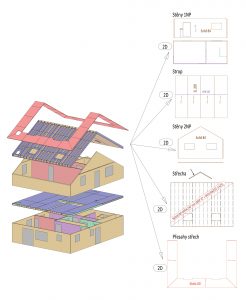For architects, NOVATOP has become a powerful tool if they are looking for novel solutions and, at the same time, simple, clean lines. For designers and structural engineers, it is synonymous with rigidity and compactness, large spans and simple construction details.
The Catalogue of Construction Details and the Design Instructions can be found in the downloads section.
The project documentation must include:
- 3D model or 2D drawings (We prefer the documents to be processed in a 3D model and the following formats: CadWork, ifc, sat, stp, BTL.)
- Ground plans
- Sections
- Views of individual walls, ceilings and roof structures
- Wall thicknesses and element specifications
- Indication of visual quality and fibre orientation
- Indication of electrical wiring
- Requirements for fire resistance (REI), sound and thermal insulation
- Construction details (types of connections and sequences)
- Connecting elements
- Warning about non-standard execution
- Preliminary assembly procedure (wall numbering)
- Static report
The price offer is prepared based on the study or the project. After it is agreed upon, a detailed check of the project documentation is performed as well as clarification of the design solutions and any recommendations for the project optimization. A 3D model of the structure is created. The requirements for thermal and sound insulation, fire resistance and visual quality are specified, and if necessary, verification of the statics of the entire building is provided. Subsequently, the installation procedure is determined and the related numbering of panels and the loading of the truck is carried out.
Due to the uniqueness of each order, the manufacturing process can be started only from the time when all project specifications are clarified. The production requires a high degree of advance planning. As for the preparation, we need approximately 6-8 weeks. The panels leave the production fully machined, fitted with identification labels including detailed specifications and wrapped in foil that protects them against moisture, dirt and damage. They are usually shipped to the customers by trucks, directly to the site where they are put together to make the structure using a crane – accurately, simply and quickly.
